Kitty Hawk Kiteboarding: The Evolution of a Thrilling Sport
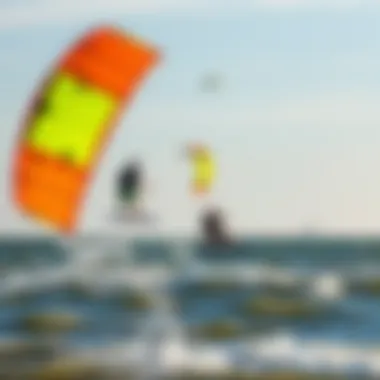
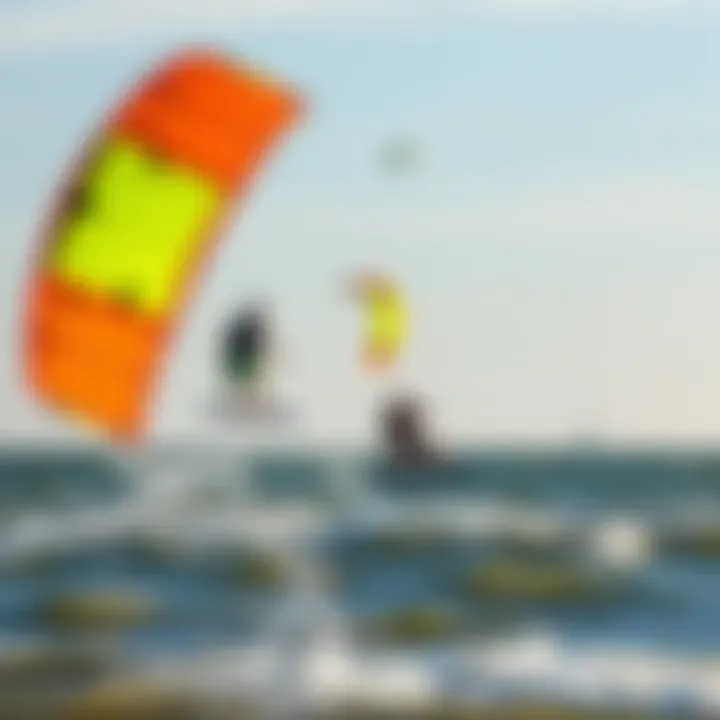
Intro
Kiteboarding, a thrilling fusion of surfing, sailing, and wind sports, has enjoyed a remarkable rise in popularity since its initial emergence. Central to this evolution is Kitty Hawk, North Carolina—a place not just notable for its history in aviation, but also for its pivotal role in shaping the kiteboarding landscape. With the ocean winds whipping around the Outer Banks, this location has attracted enthusiasts eager to harness the power of the wind and the waves.
The sport has undergone significant transformations—from the early inception of kite designs to the advanced gear we see today. As the equipment and techniques have evolved, so too has the culture surrounding kiteboarding. Getting to grips with the nuances of gear selection and skill development is crucial for anyone wishing to engage fully in this exhilarating sport.
This article seeks to unravel the layers of kiteboarding's history, its technical underpinnings, and the broader cultural impacts it has had. We'll explore the specific gear choices that can make or break an experience on the water, dive into the essential techniques necessary for mastering the sport, and provide tips for progression that can elevate one's skills.
With kiteboarding becoming an integral part of the coastal lifestyle in Kitty Hawk, its environmental impact also presents challenges and discussions that merit attention. Thus, in understanding the sport more deeply, enthusiasts can engage in more responsible and sustainable practices.
As we move forward, let's first take a closer look at the heart of any kiteboarding adventure—the gear.
Historical Context of Kiteboarding
Kiteboarding, an exhilarating sport that marries the thrill of wind and water, has its roots deeply embeded in the rich history of human flight and water sports. Understanding this historical context helps enthusiasts appreciate not only the evolution of kiteboarding as a sport but also its cultural significance over time. This section will delve into the origins of kiteboarding, intertwined with the legacy of technological advancements and social dynamics that have shaped it.
The Origins of Kiteboarding
The beginnings of kiteboarding can trace their lineage back several hundred years, linking it to the ancient Chinese who were known to use kites for various purposes, including military training and signalling. However, the contemporary form of kiteboarding that we know today began to take shape in the 1960s. Innovators like Charles Franklin and later, in the 70s, the likes of Peter Lynn stirred the pot by experimenting with various designs that combined surfing and kite flying.
The allure of rushing across water being pulled by a kite sparked interests across regions, eventually leading to the formation of modern kiteboarding. The sport gained a significant foothold in the 1990s, particularly as kite designs evolved, gradually becoming more controllable and safer for riders. Thanks to these pioneer inventors and early adopters, the sport found a solid audience and started to flourish. The marriage of outdoor adventure and the thrill of the elements turned kiteboarding into more than just a pastime; it became a lifestyle for many.
Key Milestones in the Sport's Development
Kiteboarding’s journey through the years is marked by some pivotal milestones that shaped its growth. The transition from relatively simple designs to more sophisticated equipment marks a key era.
- Introduction of Inflatable Kites: In the late 1990s, the advent of inflatable kites was a game-changer. These kites improved safety, increased reliability, and allowed for better control, which made the sport more accessible to newcomers.
- Formation of Governance Bodies: The establishment of organizations like the International Kiteboarding Association in 2001 played an essential role in promoting kiteboarding globally. It opened doors to competitions and structured training methods, helping legitimize the sport in the eyes of enthusiasts and sponsors.
- Technological Incorporation: In the 2010s, technological advancements saw equipment getting lighter, stronger, and more user-friendly. The introduction of features such as depower and quick-release mechanisms saw safer rides in varied wind conditions.
"Each of these milestones is like a building block, making the sport more exciting and safer for enthusiasts every single day."
Kiteboarding has not only grown as a sport but also as a community, evolving into a culture where respect for the sport and its environmental nuances reigns supreme. This historical lens provides a meaningful understanding of kiteboarding’s growth and its resonating impact on local communities like Kitty Hawk, making it not just a sport, but a global phenomenon.
Kitty Hawk's Role in Kiteboarding
Kitty Hawk plays a critical role in the narrative of kiteboarding, marking itself as an epicenter where enthusiasm for this thrilling sport flourished. Its geographical and meteorological advantages make it an ideal location for both newcomers and seasoned riders. Additionally, the area's rich history intertwined with the Wright brothers' pioneering spirit serves as a metaphorical wind beneath the wings of kiteboarding.
Why Kitty Hawk Became a Kiteboarding Mecca
Several factors contribute to the prominence of Kitty Hawk as a kiteboarding haven.
- Favorable Winds: The consistent winds year-round provide kiteboarders with an environment that enhances learning and experimentation. Riders of all skill levels benefit from the steady conditions, whether they’re just starting or pushing boundaries.
- Diverse Water Conditions: Kitty Hawk is blessed with a variety of water conditions, from flat, shallow spots ideal for beginners to wave-rich areas that challenge advanced kiteboarders. This diversity allows for different styles and experiences, catering to every kind of rider.
- Community and Culture: The local kiteboarding community here is vibrant and welcoming. Through informal meet-ups at beaches and organized events, riders share knowledge, skill, and camaraderie, creating a supportive environment that nurtures newcomers.
- Accessibility: Its proximity to major cities and transport links allows easy access for both local and national visitors. Being able to swing by, even for a short session, greatly boosts participation.
- Lessons and Schools: Numerous kiteboarding schools, like Kitty Hawk Kites, offer lessons that cater to a range of skill levels. These institutions not only teach the sport but also impart essential safety practices, making kiteboarding more accessible to all.
Given these factors, it's no wonder that kiteboarders flock to Kitty Hawk, not just to ride the waves, but to be part of a community that thrives on passion and the freedom that kitesurfing provides.
Influential Figures in the Local Kiteboarding Scene
The landscape of kiteboarding in Kitty Hawk has been shaped by several key players who have dedicated their lives both to the sport and its promotion. These individuals not only excel in kiteboarding but also play active roles in nurturing the next generation of riders.
- John R. Smith: Known as a pioneering instructor, John started offering classes over two decades ago. His commitment to safety and proper technique laid foundations for kiteboarding education in the area. Through his school, many local riders have developed their skills.
- Emma L. Torres: A professional kiteboarder and advocate for women's participation, Emma has created programs encouraging young women to take up the sport. Her influence extends into competitions, where she has not only competed but also mentored aspiring female athletes.
- Mike & Sarah Johnson: This couple has played an integral role in community-building efforts. By organizing regional competitions and kiteboarding festivals, they attract a diverse range of riders and help infuse fresh energy into the local scene. Their events foster friendships and networks that extend beyond kiteboarding.
In essence, these figures embody the spirit of kiteboarding in Kitty Hawk. They have cultivated an environment where riders are encouraged to explore, innovate, and express themselves on the water, shaping a culture that ensures the sport’s past, present, and future remains vibrant.
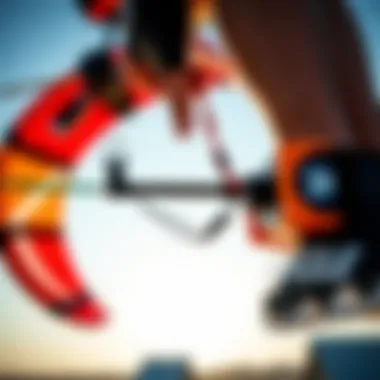
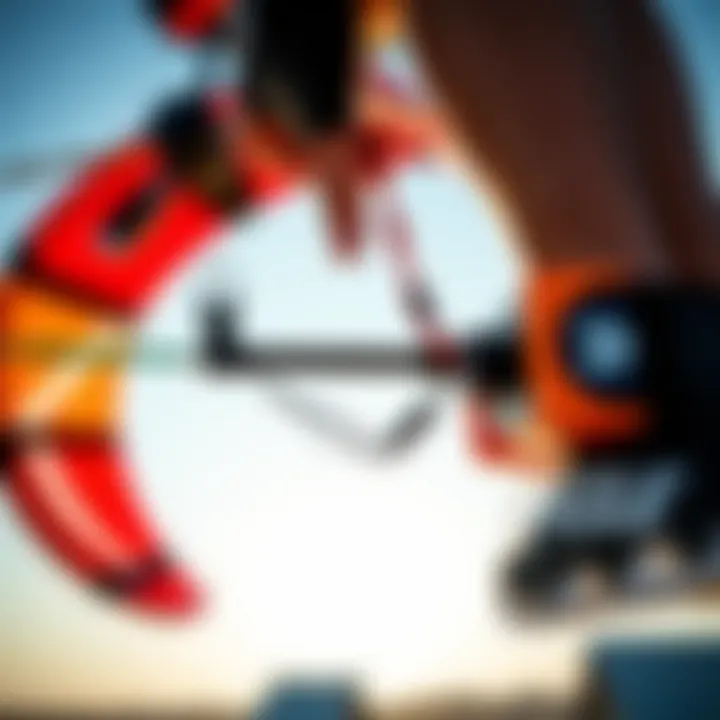
Technical Aspects of Kiteboarding
The realm of kiteboarding is not just a testament to the thrill of riding the wind and waves; it's also a field deeply rooted in technology and design. Understanding the technical aspects of this sport is essential for both novices and seasoned riders alike. By delving into the intricacies of kite design, essential gear, and safety equipment, kiteboarders can optimize their performance and ensure their safety on the water. This section sheds light on how these technical dimensions contribute to the overall experience of kiteboarding, making every ride not only enjoyable but also compellingly safe.
Understanding Kite Design and Functionality
Kite design is the backbone of the kiteboarding experience. It’s not just about how flashy the colors are or whether it matches your board; the design significantly impacts how the kite performs in different wind conditions and rider skill levels.
The primary components of a kite include the canopy, leading edge, and control lines. Each of these elements serves a unique purpose:
- Canopy: This is the fabric that catches the wind. Depending on the shape and size of the canopy, kites can be categorized into different styles like bow kites, delta kites, and C kites. Each design offers distinct handling qualities and performance metrics.
- Leading Edge: The rigid frame of the kite, the leading edge enables the kite to maintain shape under various wind pressures. An adaptable leading edge will ensure better stability and responsiveness.
- Control Lines: The lines that connect the kite to the rider. These lines come in various lengths and materials, influencing the kite's responsiveness and the rider's ability to maneuver.
Understanding how these components work together helps riders select the appropriate kite for their skills and local wind conditions. As riders evolve in skill, they often find themselves choosing kites that allow for more advanced techniques, enhancing both performance and enjoyment.
Essential Gear for Peak Performance
Beyond the kite itself, having the right gear can elevate the kiteboarding experience to astonishing heights. The selection of equipment is vast, but there are several essentials that every kiteboarder should consider:
- Board: A good quality board should match your skill level and the conditions you intend to ride in. Freestyle boards, for example, are typically shorter and more maneuverable, while freeride boards are often designed for stability and comfort.
- Harness: This is your lifeline to the kite. A well-fitting harness distributes the pull of the kite across your body, helping prevent fatigue and injuries.
- Bar and Lines: These not only allow control over the kite but also impact how responsive the kite is to rider inputs. Choosing a bar that fits comfortably in your hands and has easy-to-use safety features is crucial.
Furthermore, some riders opt for accessories like foot straps or pads, which can provide extra support and comfort. Investing in high-quality gear that suits your personal style and riding level is fundamental for achieving peak performance on the water.
Safety Equipment: An Overview
Safety must always be a priority in kiteboarding. With the inherent risks associated with wind and water, having the right safety equipment can mean the difference between an exhilarating ride and a harrowing experience. Consider the following safety gear:
- Impact Vest: Protective vests not only offer buoyancy but also shield the rider during falls. They are designed to absorb shock and prevent injuries from sudden impacts.
- Helmet: A helmet is an indispensable safety accessory, especially for those learning new tricks or riding in busy areas. It protects against head injuries in case of accidents.
- Quick Release System: This system helps detach the rider from the kite in emergency situations. Familiarizing oneself with the quick release system can save lives.
Moreover, ensuring that all safety equipment is properly maintained and regularly checked can alleviate potential risks. Remember, kiteboarding should be fun, but it should also come with peace of mind.
"Preparation is key. It can improve not just your performance, but your overall kiteboarding experience as well."
By honing in on these technical aspects of kiteboarding, enthusiasts can refine their skills while promoting a culture of safety and performance within the community. As the sport continues to evolve, a strong grasp of its technical elements remains imperative for every kiteboarder, from budding enthusiasts to seasoned veterans.
Riding Techniques for All Skill Levels
Understanding the various riding techniques in kiteboarding is paramount, no matter a rider's experience level. When one starts out, it may look daunting initially, but the journey of mastering the sport unfolds gracefully over time. From the novice who's just getting acquainted with the board and kite to the seasoned professional executing stylish maneuvers, each phase has its merits and hurdles. This section serves as a gentle guide, equipping kiteboarders with foundational and advanced techniques, thus elevating their skills and ensuring that every ride is more enjoyable and safe.
Fundamental Techniques for Beginners
For those who are just stepping onto the kiteboarding scene, grasping foundational techniques is key. These essential skills form the bedrock of all subsequent maneuvers and challenges.
- Kite Control: Learning to maneuver the kite is fundamental. The kite's positioning in the wind window affects speed and direction. Beginners should practice flying the kite on land to understand its responsiveness.
- Body Positioning: Proper stance helps maintain balance. Riders should adopt a slight bend in their knees, keeping their body relaxed while facing forward, which aids in stability when carving through the water.
- Board Basics: Familiarity with the board is critical. Beginners must practice getting up from the water, finding their stance, and maintaining edge control. This understanding paves the way for more advanced skills.
- Safety First: Being aware of one’s surroundings and using safety equipment is non-negotiable. Beginners should wear appropriate gear, including a harness, life jacket, and a helmet, as these can greatly enhance safety during initial rides.
The learning curve for beginners can have its ups and downs, but the thrill of catching a first wave or simply getting the kite in the air often proves the most rewarding experiences.
"The adventure begins not just with a kite, but with confidence in your abilities."
Advanced Maneuvers for Experienced Riders
As riders gain experience, they naturally begin to crave more challenging techniques. Here’s where the fun intensifies and creativity flourishes. Advanced tricks not only showcase skill but also elevate a rider’s overall enjoyment of kiteboarding.
- Transitions: Perfecting transitions allows riders to shift directions smoothly. This involves a combination of timing and body movement, which, when executed properly, can make for visually captivating riding.
- Jumping: Getting air can be an exhilarating experience. Riders must learn to edge hard, generate speed, and timing the kite's lift to launch off the water. Smooth landings are just as crucial to master.
- Tricks and Spins: Adding spins while jumping introduces a flair to the routine. Advanced riders often explore variations like the handle pass or backroll, each requiring significant practice and focus.
- Wave Riding: For those who venture into wave riding, learning how to harness the wave dynamics is essential. Riding the waves requires a different approach to kite control and positioning to maximize fun and minimize risks.
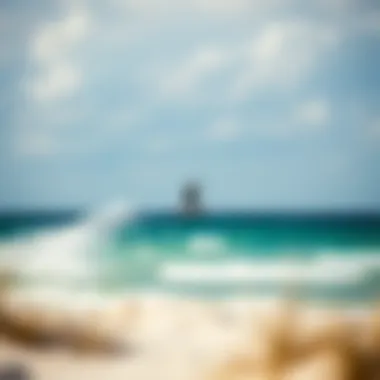
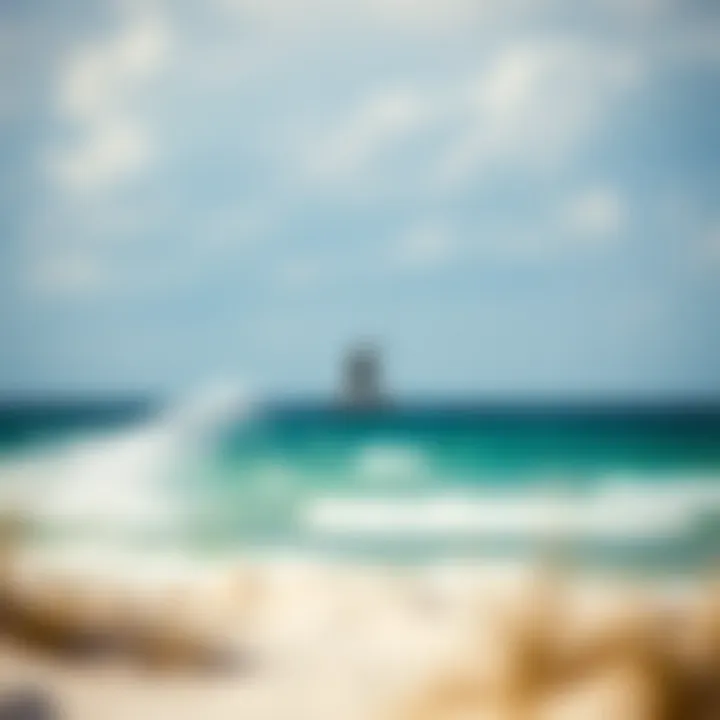
Each of these advanced techniques requires not only skill but also a solid understanding of conditions, kite behavior, and physical responsiveness. As riders hit the water, they’re not just aiming for the moon; they're learning to fly.
Environmental Considerations in Kiteboarding
Kiteboarding, while thrilling and mesmerizing, brings with it a responsibility towards our natural surroundings. The synergy between this adrenaline-fueled sport and the environment carries significant weight. Understanding how kiteboarding impacts local ecosystems, as well as promoting responsible practices among riders, is crucial for ensuring the long-term viability of both the sport and the environment it thrives in.
Impact on Local Ecosystems
Kiteboarding is often performed in scenic coastal areas, which are biodiverse and sensitive ecosystems. As riders zip across the water, there are several ways their activity can impact local flora and fauna. For starters, the presence of kites and the movement of boards can disturb wildlife that resides near or on the beaches. Birds may be startled, and marine life can be affected by the ripples and turbulence caused by the boards.
Additionally, coastal ecosystems like dunes and marshes are not just picturesque backdrops; they play a vital role in maintaining ecological balance. These areas can erode or become damaged due to increased foot traffic or improper anchor placement by kiteboarders setting up their gear. This can lead to detrimental effects, such as loss of habitat for critical species.
To mitigate these impacts, kiteboarders should:
- Stay on designated paths when accessing beaches to minimize disturbance to flora.
- Avoid kiteboarding during sensitive breeding seasons for local wildlife, particularly in gull or nest areas.
- Respect local regulations and guidelines that protect environmental sanctuaries.
Kiteboarding Destinations Around the World
Kiteboarding is not merely just a sport; it's an experience shaped by wind, water, and community. Understanding the best kiteboarding destinations around the globe is essential for any enthusiast. This section looks at renowned spots and lesser-known gems that cater to riders of all skill levels. Each location blends its unique environmental features and cultural elements, providing opportunities for thrilling adventures and personal growth.
Top Locations for Kiteboarding Enthusiasts
When considering prime kiteboarding locations, the first places that typically come to mind are those renowned for their consistent winds, expansive flat waters, and welcoming communities. Here are several top locations that kiteboarders flock to:
- Cabo Verde, Africa: A paradise for those craving strong winds and warm weather, Cabo Verde offers pristine lagoons and stunning backdrops that can leave one breathless.
- Maui, Hawaii: Known for its wave conditions, Maui attracts advanced riders looking to test their skills against nature’s might. The North Shore, particularly, has become legendary among the kiteboarding community.
- Tarifa, Spain: Often called the "wind capital of Europe", Tarifa provides varied conditions suitable for all levels. Its lively atmosphere and vibrant nightlife add to the charm.
- Paje, Zanzibar: With its turquoise waters and palm tree-lined beaches, Paje is a must-visit for riders seeking both beauty and adventure. The shallow waters are perfect for beginners.
- Lake Garda, Italy: This spot merges stunning scenery with reliable wind, making it a favorite among European kiteboarders. The local culture also offers a taste of Italian charm and relaxation.
Hidden Gems for the Adventurous Rider
While the well-known kiteboarding destinations certainly have their merits, sometimes the real treasures lie off the beaten path. Here are some hidden gems that adventurous riders should consider:
- Mongolia's Uvs Lake: Remote yet breathtaking, the expansive waters of Uvs Lake promise tranquility and wind-filled days for intrepid kiteboarders willing to trek.
- Tulum, Mexico: Beyond its beaches, Tulum features lesser-known spots that offer consistent winds and fewer crowds. It's perfect for those who seek a chilled vibe amid nature.
- Canggu, Bali: More than just surfing, the winds here can be exhilarating during the right season. You'll find a growing community alongside stunning rice fields nearby.
- Sundarbans, India: A unique experience, kiteboarding in this mangrove delta offers challenging conditions and a chance to witness diverse wildlife.
- Coast of Essaouira, Morocco: With consistent thermal winds and a strong cultural scene, Essaouira is perfect for those who appreciate a mix of adventure and exploration.
"The beauty of kiteboarding is that it can take you to places you've never imagined and introduce you to cultures that enrich your experiences"
As you set your sights on the kiteboarding horizon, it's vital to remember that each destination holds its own unique character. The thrill of finding that special spot - whether renowned or obscure - can add numerous layers of joy to your kiteboarding journey.
Community and Culture of Kiteboarding
Kiteboarding is not just a sport; it's a culture defined by camaraderie, shared passions, and a love for the wind and waves. In areas like Kitty Hawk, this culture thrives through deep connections among its participants. The community aspect of kiteboarding fosters a sense of belonging. Riders come from all walks of life but share the love of the ocean and adrenaline. Newcomers find themselves embraced by seasoned riders, creating a unique environment where knowledge exchange and mentorship are commonplace. This dynamic is essential, as the sport continues to evolve and diversify.
The advantages of being part of a kiteboarding community are manifold. First, there's the knowledge-sharing: Experienced riders pass down tips, tricks, and safety protocols. Second, community-sponsored events help keep kiteboarding alive and exciting, offering platforms for informal races or local competitions. Furthermore, group gatherings mean that individuals can learn new techniques and discover the latest gear innovations together.
However, it's important also to consider the challenges that come with this close-knit culture. Occasionally, competitive spirits can overshadow the inclusivity of the community. New riders might feel intimidated if they believe they have to match the skills of veterans instantly. Here, education and encouragement are critical to preserving the sport's welcoming nature.
Building Relationships Within the Kiteboarding Community
In the kiteboarding world, relationships often form more easily than in other sports, mainly due to the supportive nature of its participants. Most riders value the ability to connect with like-minded individuals who share an exhilaration for flying a kite across the water.
Here are some avenues through which these relationships blossom:
- Local Meet-ups: Regular gatherings at popular spots in Kitty Hawk create opportunities for riders to meet.
- Workshops and Training Sessions: Organized classes can unite experienced instructors with novices, facilitating friendships.
- Social Media Groups: Online platforms like Facebook host various groups where riders can share experiences and arrange meet-ups.
Engaging with the community also broadens one's network, opening doors to collaborations, sponsorships, or even business opportunities within the kiteboarding ecosystem. Learning from each other not only enhances skills but cultivates lifelong friendships.
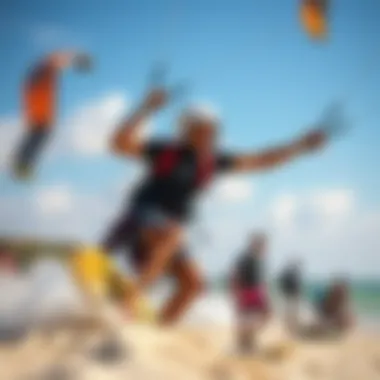
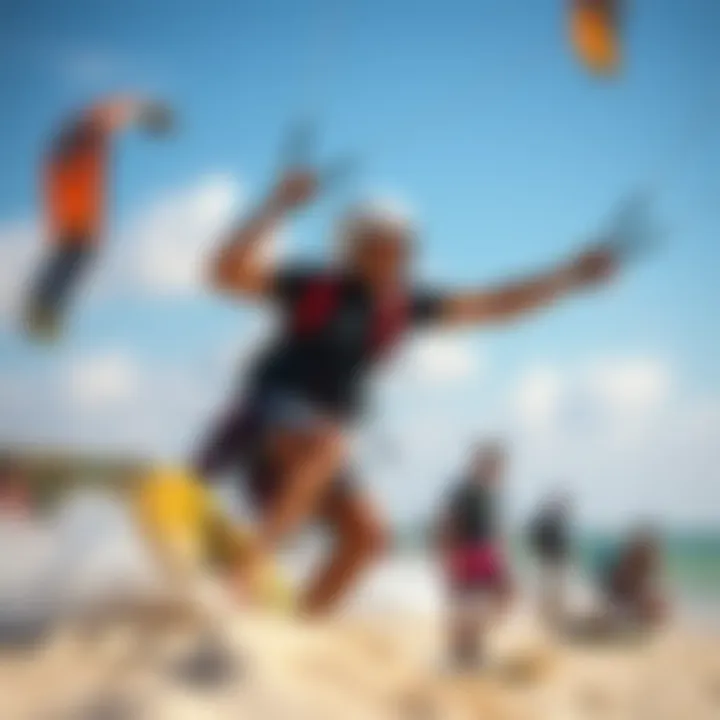
Kiteboarding Events and Competitions
Events and competitions play a pivotal role in the kiteboarding landscape, serving as both a showcase for talents and a means to fortify community bonds. From local friendly competitions to more prestigious international events, these gatherings attract riders and fans alike, fostering a spirit of fun and healthy competition.
Some key components of these events include:
- Local Competitions: Small, community-based competitions can encourage novice riders to participate and improve their skills.
- Festivals: Celebratory events often contain music, food, and kiteboarding demos, creating a festive atmosphere for families and spectators. Check events like the Kiteboarder Festival for exciting competitions in Kitty Hawk.
- International Competitions: Larger-scale events provide a greater platform for professional athletes to showcase their talents, thus inspiring up-and-coming riders.
"The best part of any kiteboarding event? It’s not just about winning; it’s about the friends you make and the memories you create together."
With events constantly evolving, they often serve as focal points for innovation in kiteboarding gear and techniques. Furthermore, they prove to be excellent opportunities for rider interaction and have immense potential for media exposure, which in return elevates the sport's presence. By participating in these events, riders contribute to the culture while also promoting the sport on larger platforms.
Current Trends and Innovations in Kiteboarding
Kiteboarding has seen remarkable change over the years, driven by innovation and a keen desire among enthusiasts to push the boundaries of the sport. It's more than just riding the waves or catching air; it's about integrating technology and style to elevate the experience. As we dive into this part of the article, we'll explore the current trends shaping kiteboarding, highlighting what's new and noteworthy in gear, techniques, and the community experience.
Technological Advancements in Equipment
The equipment used in kiteboarding is where the most visible advancements have occurred. Over the years, kite designs have evolved significantly, focusing on improving performance, safety, and user comfort. New materials, like ultra-lightweight fabrics, are becoming common in kite production. They not only enhance durability but also enable better responsiveness in various wind conditions.
Additionally, developments in control systems, including one-pump inflation systems, make setting up and launching quick and easy. Riders can now inflate their kites in a fraction of the time it used to take.
Several brands have introduced smart technology into their setups. Some kites come equipped with integrated sensors that monitor performance metrics, such as speed and altitude. This data can provide real-time feedback that helps riders refine their techniques, which shows how kiteboarding is embracing the digital age.
"Innovation is a wind that lifts the kiteboarding community to new heights, both literally and figuratively."
Furthermore, safety equipment has also taken a leap forward. Many harnesses now include features like integrated flotation or emergency release mechanisms, ensuring that even in tricky situations, riders are more secure.
Emerging Styles and Riding Techniques
As the sport continues to grow, so does the variety of styles and techniques that riders adopt. Riders are beginning to experiment with hybrid styles, blending elements from other water sports like surfing and wakeboarding. This trend is not just about differentiation; it’s about expressing personality and pushing the physical limits of what’s possible when on the water.
Freestyle kiteboarding, with its mix of tricks and acrobatics, has gained a following due to the viral nature of social media. Enthusiasts often post jaw-dropping videos showcasing new maneuvers, prompting others to hone skills and create new moves. On the other hand, wave riding is re-emerging as a significant trend, emphasizing the joy of riding through the surf rather than just aerial tricks.
Also, the rise of foilboarding represents a fascinating evolution in surfing style. Foils allow riders to glide above the water, creating a smoother experience that opens new possibilities for riding conditions that would normally be too choppy. This style attracts a range of kiteboarders, from those looking for a new challenge to those who seek a quieter day on the water.
As we look to the future of kiteboarding, it is clear that innovation will continue to redefine the sport, attracting new participants and encouraging seasoned riders to explore fresh avenues of expression. Innovations not only improve performance and safety but also enhance the sport's appeal to a broader audience.
The Future of Kiteboarding
As kiteboarding continues to capture the hearts of thrill-seekers around the world, it's essential to look ahead and consider what lies in store for this exhilarating sport. The future of kiteboarding is marked by advancements in technology, a growing community, and a pronounced emphasis on environmental sustainability. These elements will not only shape the sport but also determine how it evolves and grows in the coming years. Understanding these aspects can provide kiteboarders, instructors, and enthusiasts insightful perspectives on their passion.
Predictions for the Sport's Growth
Looking forward, the trajectory of kiteboarding seems promising. Several factors indicate growth potential:
- Increased Popularity: The sport is gaining traction worldwide with new enthusiasts joining every season, driven by social media influences and adventure travel.
- Advancements in Technology: Continuous innovations in equipment, such as lighter and more durable materials, are making the sport more accessible. This means that even those who are new to kiteboarding will have better gear, enhancing their learning experience and enjoyment.
- Diverse Locations: Kiteboarding hotspots are expanding beyond traditional areas. New destinations emerge as local communities develop facilities and promote the sport. For instance, places with consistent winds and suitable conditions are increasingly tapped into, attracting more riders.
- Youth Engagement: Kiteboarding organizations are focusing efforts on youth programs to teach the next generation. As younger kids start kiteboarding, they bring fresh perspectives that can lead to new styles and techniques.
The landscape is ripe for kiteboarding's growth, driven by a passion for exploration and adventure that resonates profoundly across various cultures.
The Role of Environmental Sustainability
With growth comes responsibility. The future of kiteboarding hinges not just on the thrill of the ride but also on how it interacts with the environment. Here are a few considerations for keeping the sport sustainable:
- Minimal Ecological Footprint: Riders and organizers alike must embrace sustainable practices, such as choosing eco-friendly materials for gear and transportation to kite spots.
- Beach Cleanup Initiatives: Local kiteboarding communities can engage in cleanup efforts to preserve the natural beauty of the places where they ride. This promotes environmental awareness and fosters a sense of stewardship among kiteboarders.
- Education and Advocacy: Being informed about local ecosystems and their needs is vital. Kiteboarders should advocate for local conservation efforts and engage with environmental organizations.
- Responsible Riding Practices: Practicing kiteboarding in designated areas and respecting wildlife can help minimize the impact on vulnerable environments. Creating a culture of mindfulness among riders can encourage responsible behavior across the board.
"The health of the sea and winds should always be a priority. Protecting our playgrounds ensures future generations can experience the joy of kiteboarding just as we have."
The fusion of kiteboarding with environmental awareness is essential for the sport's longevity. The community's response to these challenges will no doubt play a pivotal role in how kiteboarding is perceived and enjoyed in the years to come.















